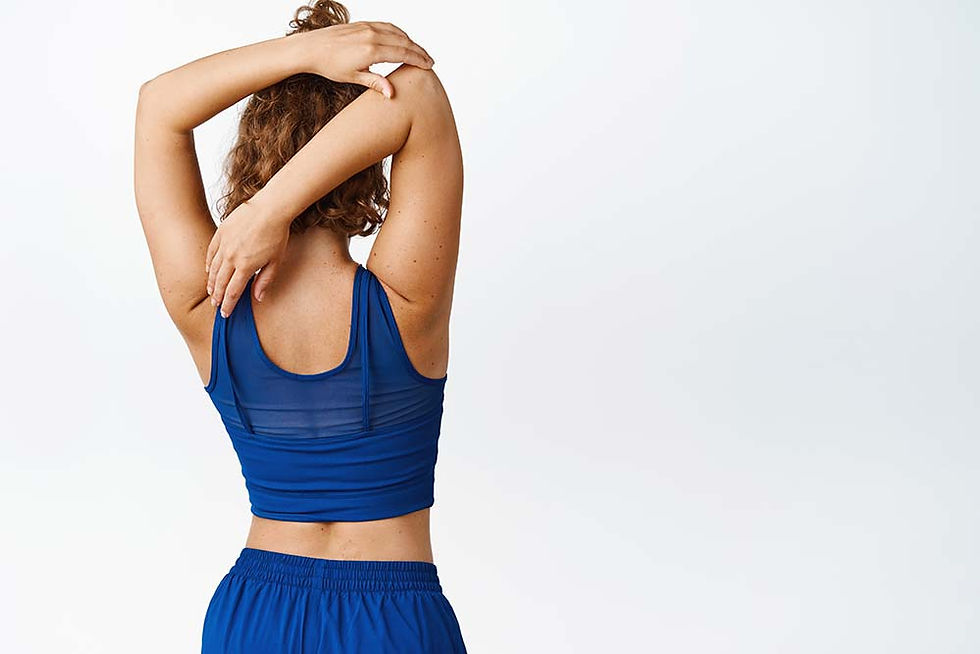🧍♀️ Is Your Posture Holding You Back?
- Withyou
- Jun 20
- 3 min read
How to Recognize and Fix a Kyphotic-Lordotic Posture
In today’s digital world, most of us spend hours every day sitting—at a desk, in the car, on the couch, or scrolling through our phones. While it may not seem like a big deal, prolonged sitting and poor posture can lead to long-term spinal issues, including what’s called Kyphotic-Lordotic Posture. Let’s dive into what this posture is, what causes it, and how to correct it with some simple, effective exercises.

🔍 What is Kyphotic-Lordotic Posture?
In a healthy standing posture, your spine should have a gentle S-curve when viewed from the side, with your ear, shoulder, and hip aligned in a straight vertical line.However, in Kyphotic-Lordotic Posture, the upper back (thoracic spine) rounds excessively forward (kyphosis), while the lower back (lumbar spine) arches too far inward (lordosis).This misalignment can create uneven stress on your joints and muscles, leading to chronic discomfort or even injury over time. ⚠️ Common Causes
Sitting for long periods (desk jobs, driving)
Excessive phone or computer use
Past injuries (car accidents, falls)
Osteoporosis
Genetic or congenital spinal conditions
Structural changes like wedge-shaped vertebrae (Scheuermann’s disease)
🚨 Potential Complications
If left uncorrected, this posture may lead to:
Lower back pain (from facet joint compression)
Pinched nerves
Degenerative disc or joint conditions
Limited mobility due to stiffness
Difficulty breathing
Digestive problems
Poor body image and posture-related stress

💡 What Muscle Imbalances Look Like
Kyphotic-lordotic posture typically involves an imbalance between tight and weak muscle groups:
🟥 Tight/Overactive Muscles
Upper traps
Chest (pectorals)
Hip flexors (iliopsoas)
Quadriceps
🟦 Weak/Underactive Muscles
Abdominals
Glutes
Lower traps
Deep neck flexors
To restore proper posture, we need to lengthen tight muscles and strengthen the weak ones.

🧘♀️ 5 Exercises to Improve Your Posture
1. Chest Stretch
Stand in a doorway with your forearms against the frame. Lean forward gently until you feel a stretch across your chest.
🟢 Opens the chest and reduces tightness from slouching.
2. Hip Flexor Stretch
Kneel on one knee, gently tucking the pelvis under. Shift your weight forward until you feel a stretch in the front of your hip.
🟢 Helps reduce excessive lower back arching by loosening the hip flexors.
3. Child’s Pose
Kneel on a mat and reach both arms forward as you fold your upper body down.
🟢 Gently stretches the spine and back muscles.
4. Lower Traps Strengthening
Lie on your stomach, arms by your sides. Lift your arms slightly off the floor and gently squeeze your shoulder blades together.
🟢 Activates the muscles that support your mid-back and shoulder stability.
5. Core Strengthening (Plank)
On your forearms and toes, keep your body in a straight line from head to heels. Don’t let your hips sag!
🟢 Builds abdominal strength and supports spinal alignment. 🩺 Expert Insight
“Kyphotic-lordotic posture is especially common in women and those with a history of back or disc problems. If left untreated, it can contribute to accelerated joint wear and chronic pain. That’s why awareness and daily correction are so important.” – Dr. HyeYam Ma, Chiropractor at SIGMA Rehab
✅ Final Thoughts
Posture problems may seem minor, but they can seriously impact your comfort, confidence, and overall health.Take a few minutes each day to stretch and strengthen your body—and check your posture in the mirror!
Small changes today can lead to big improvements tomorrow. 🧘♂️✨

Dr. Hyemi Ma 마혜미 원장
SIGMA CHIROPRACTIC & REHAB CLINIC
시그마 척추 관절 클리닉 (647) 349-9355
Enjoy shopping @Galleria Supermarket!









Comments